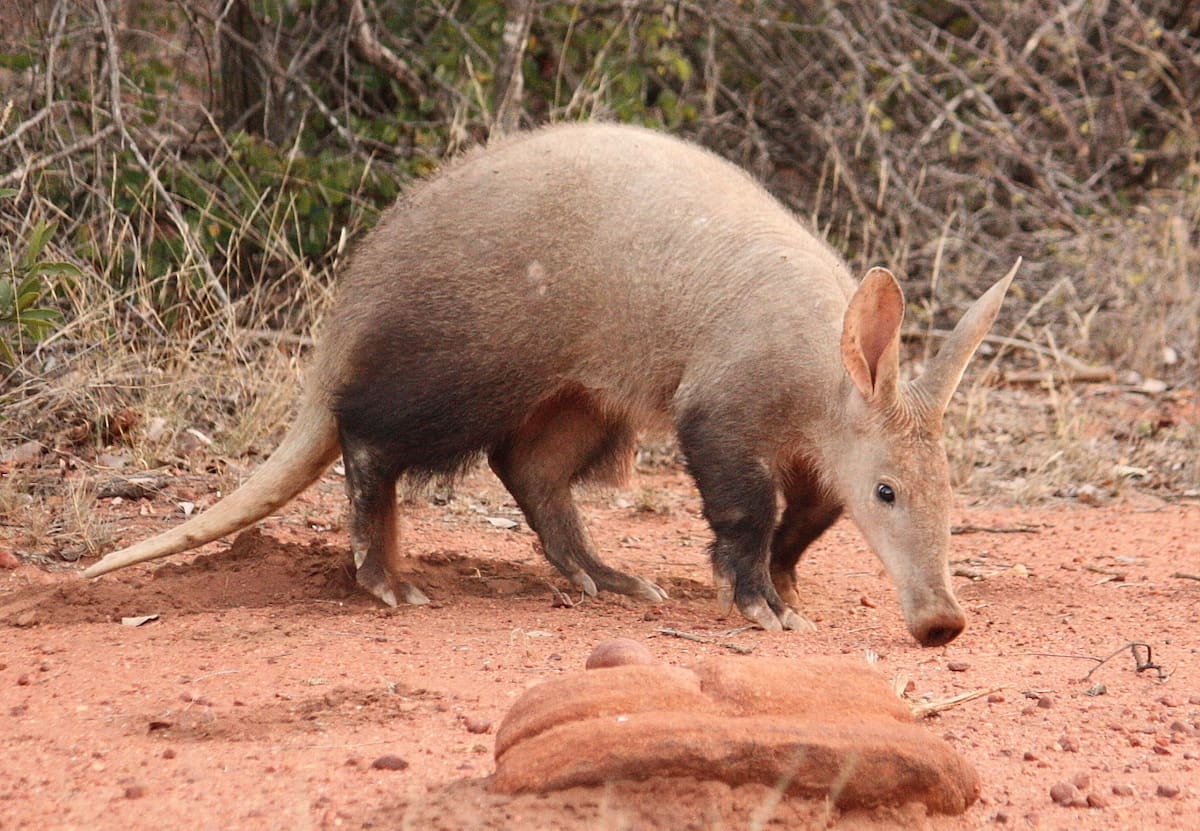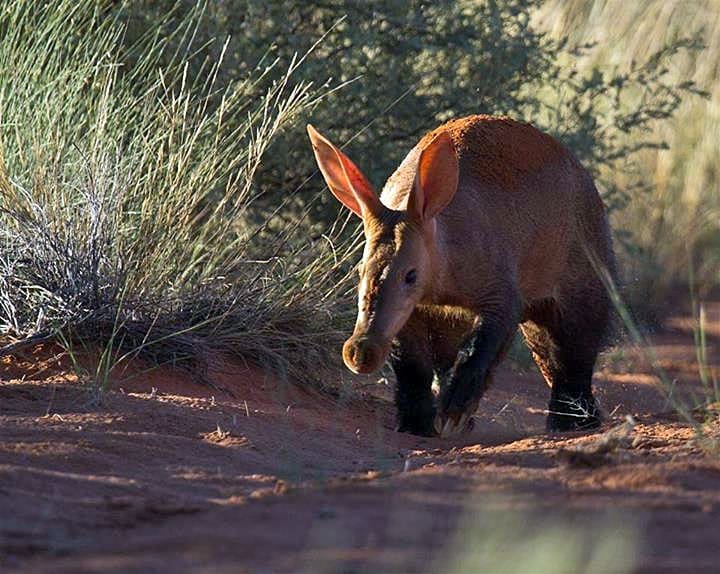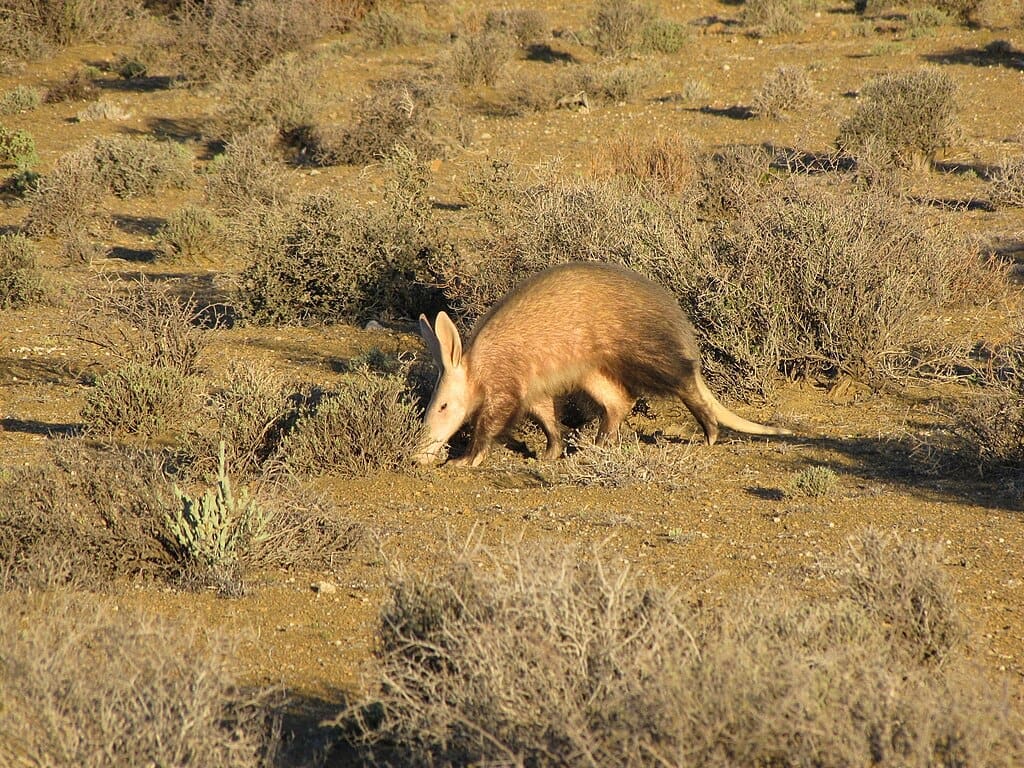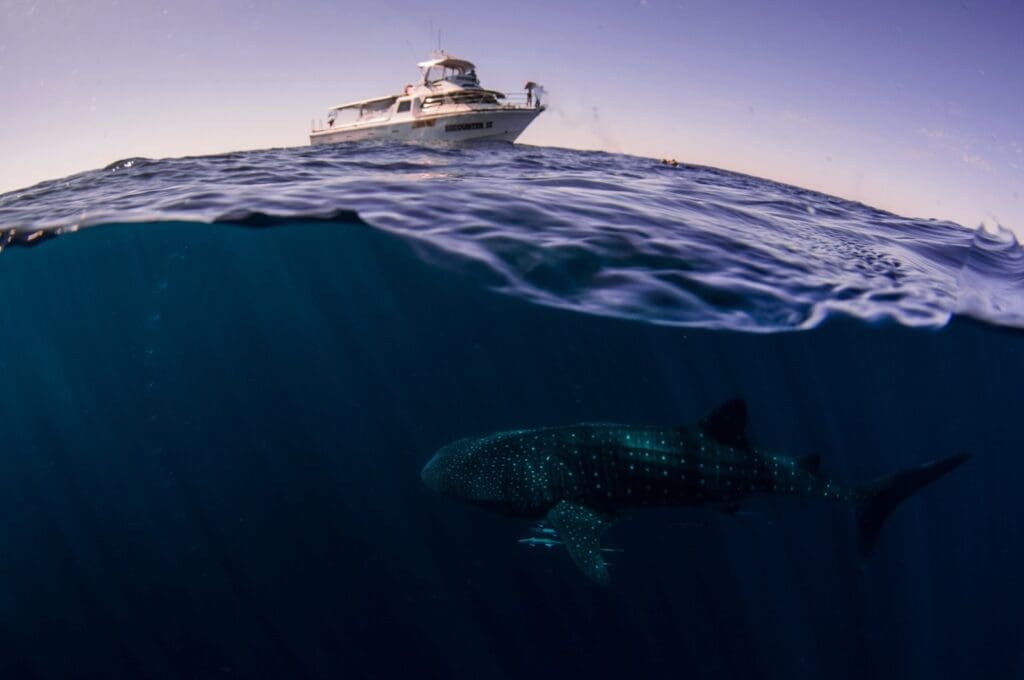What unique animal could be a cross between a rabbit, a pig, an opossum, and an anteater?
The aardvark!

Meet the aardvark – a one-of-a-kind mammal native only to sub-Saharan Africa.
The aardvark has an unusual hodge-podge mix of features including rabbit-like ears, a pig-like snout, an opossum-like tail, and a long, sticky anteater-like tongue. This creature has large and formidable claws used for digging and defense. Weighing in at 115 – 180 pounds, the aardvark is much heftier than it looks.
Aardvarks inhabit the savannas, arid grasslands, and bushlands of sub-Saharan Africa where there is plenty of their favorite prey, ants and termites. They are solitary and do not socialize with others unless for mating or raising young. They live for about 18 years in the wild and approximately 25 years in captivity.
The aardvark is famous for being the first noun in the English dictionary. The animal goes by many names including Cape anteater and ant bear, but its colloquial moniker, aardvark, is Afrikaans for “earth pig”.

Odd Relatives
Although the aardvark is an eater of ants, it is not an anteater. Understandably, the comparison comes from its similar appearance and nearly identical diet to the anteater, which leads people to assume they are the same animal. However, the aardvark is its own species entirely, and in fact, it is more closely related to elephants than to anteaters.
Unique Diet
Aardvarks are insectivores that eat ants and termites. They use their keen sense of smell to locate ant nests and termite mounds over great distances. Aardvarks have the highest number of olfactory turbinate bones of any mammal on the planet. An aardvark has about 9 -11 of these specialized bones which help support the olfactory bulb in the brain, where smells are processed. This larger-than-average olfactory system allows the aardvark to track such tiny creatures like ants and termites from far away. They have been observed swinging their heads back and forth close to the ground, much like a metal detector, to pick up a scent.
Once an aardvark locates a termite mound, it uses its claws to break open the cement-hard structure. Its tongue, coated in sticky saliva, slurps up the exposed insects in seconds. The highly adapted tongue of an aardvark can be up to 1 foot long. Over the course of a night, a single aardvark eats over 45,000 termites. Amazingly, all of this is done without chewing.
While aardvarks are classified as insectivores, they make one exception in their diet for a very unique fruit, the aardvark cucumber. This African melon looks similar to a cantaloupe but is grown completely underground. Aardvarks easily dig up the fruit and eat its watery, seed-filled interior. Once the fruit is digested, the seeds are dispersed by the aardvarks that cover their dung in dirt, effectively planting these seeds in the soil with a natural fertilizer. This symbiotic relationship helps propagate the aardvark cucumber, whose existence is entirely dependent upon the aardvark.

Cultural Significance
The aardvark is regarded as a symbol of resilience in some African cultures due to its unrelenting bravery in tearing down termite mounds. The aardvark has very thick skin which helps avoid injury from hundreds of termite and ant bites. Because of their nocturnal habits and solitary nature, aardvarks are not a common sight during the day. It is said that anyone who is lucky enough to see one is blessed.
Earth Engineer
Aardvarks are adept earth-movers known to create specialized burrows to live in. These burrows provide shelter away from the sun and from predators. Its powerful claws are specially adapted to move massive amounts of dirt in minutes, which helps the aardvark excavate multiple chambers within the den.
Some burrows can be up to 10 feet deep and over 20 feet long. There are multiple entrances to the same burrow so the aardvark has a chance to escape if a predator poses a threat. Aardvarks have been observed to be very cautious creatures and practice an unusual ritual before exiting their abode. The aardvark stands at the edge of its burrow and uses its excellent sense of smell to detect any nearby predators. It listens for danger and emerges slowly. The aardvark then jumps a few times, pauses, and heads out for the night. Because aardvarks are primarily nocturnal, they don’t have much need for vivid sight and are colorblind. Their long ears and nose do the seeing for them.
The physiology of these soil architects may strike some as strange, but it serves a purpose. The odd, arched silhouette of the aardvark is caused by its hind legs being longer than its front, which gives them a stronger stance when digging. This adaptation, combined with their formidable claws and muscular forelimbs, allows the aardvark to dig a hole 2-feet deep in just 30 seconds – much faster than a human with a shovel.

Ecological Importance
When aardvarks have depleted most of their territory’s termite mounds or ant nests, they must move on to new hunting grounds. Their abandoned burrows don’t stay empty for long and are occupied by a variety of species. Hyenas, wilddogs, warthogs, civets, and porcupines make their homes in aardvark burrows. The aardvark has an incredible impact on its environment by sculpting the very landscape itself and providing shelter for other creatures.
If you want to learn more about how aardvark burrows support other animals, check out this article documenting the one of the first observations of predators and prey cohabitating in the same burrow.
Burrowing away now,
Joely

Joely Hart is a wildlife enthusiast writing to inspire curiosity about Earth’s creatures. She holds a Bachelor’s degree in creative writing from the University of Central Florida and has a special interest in obscure, lesser-known species.
Sources and Further Reading:
https://www.miamiherald.com/news/nation-world/world/article274890346.html
https://www.thoughtco.com/10-facts-about-aardvarks-4129429
https://a-z-animals.com/animals/aardvark/
https://animalia.bio/aardvark#facts
https://www.britannica.com/animal/aardvark
https://carnegiemnh.org/a-is-for-aardvark/
https://nationalmuseumpublications.co.za/aardvarks-orycteropus-afer-and-their-symbolism-in-african-culture/



